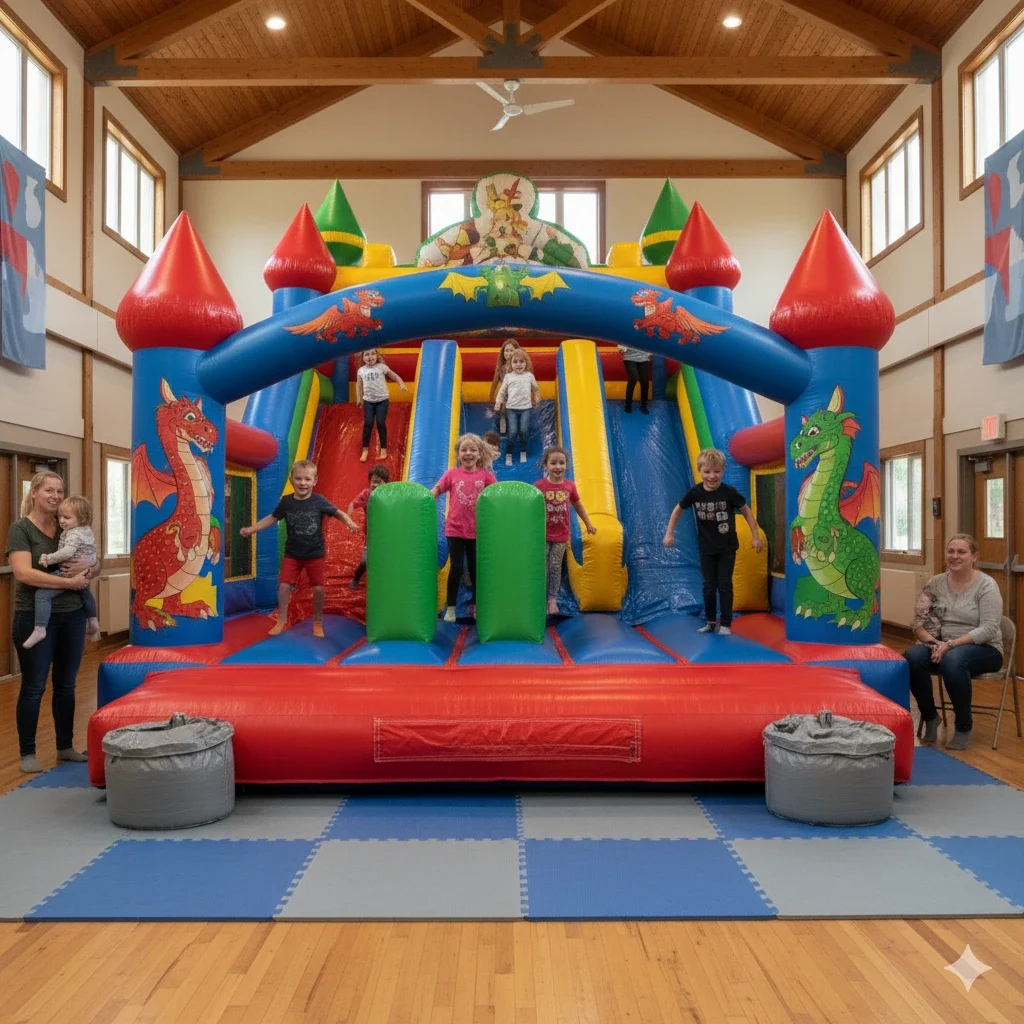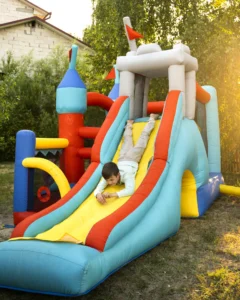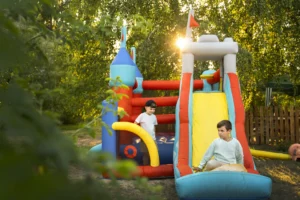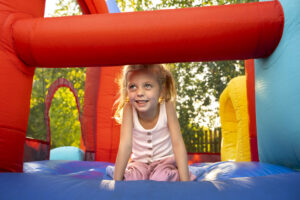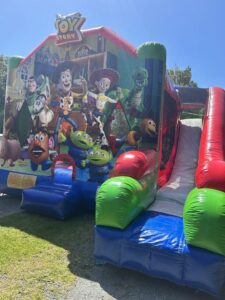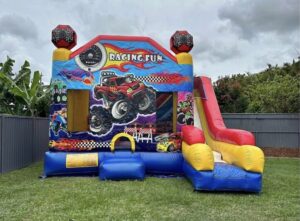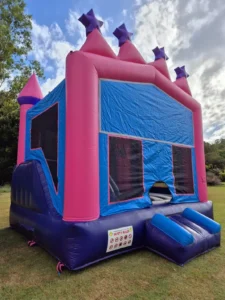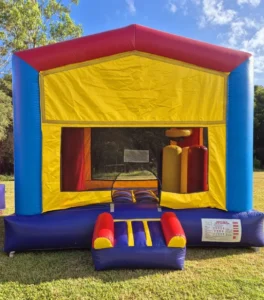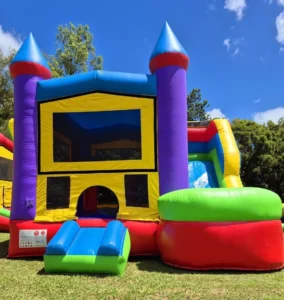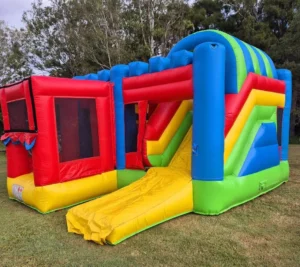Securing a bounce house indoors is safer than you might think and helps avoid weather-related issues like wind or rain. Use weighted anchors such as sandbags, clear at least six feet of space around the unit, and always supervise play to reduce risk. Regular inspections and maintenance help keep your setup clean, secure, and fun for everyone.
How to Safely Set Up and Secure a Bounce House Indoors
When you want to learn how to secure a bounce house indoors, the good news is that it can be simpler than you think. Many families find that indoor setups solve weather-related worries altogether. In fact, about 15% of bounce house accidents happen because of poor placement or unstable ground outside. By moving the party indoors, you reduce the risk of wind gusts, rain-soaked surfaces, and blazing summer heat. Still, proper anchoring is just as important inside as it is outdoors, and that’s exactly what we will cover here.
Clear a safe area
Start by identifying a spacious, open section of your indoor space. You want a spot that has:
- Enough overhead clearance to accommodate the height of your bounce house
- Easy reach to power outlets without messy cords in walkways
- A soft surface, like carpet, or a tarp on hardwood floors to protect both your floor and the bounce house
Make sure any furniture or fragile items are moved at least six feet away so that children who tumble out have a safe landing zone. Studies recommend a clearance radius of about six feet to prevent punctures or collisions with sharp objects (PlaySmol). Also, check your bounce house’s manufacturer guidelines for weight and capacity limits before finalizing your setup spot.
Choose the right anchors
When you anchor indoors, you cannot rely on ground stakes or yard pegs. Instead, sandbags or other weighted anchors will keep your bounce house stable:
| Method | Pros | Cons |
| Sandbags | Great for indoor use, no need for ground staking | Can be heavy and messy if torn |
| Weighted frames | Provide a secure hold with metal brackets | Might take up extra floor space |
| Commercial anchors | Typically designed for versatile indoor setups | May require additional purchase |
Brands like HeroKiddo recommend sandbags, deadman anchors, or concrete blocks for extra stability if your floor is particularly smooth or if children will be bouncing with a lot of energy. Whichever anchor system you choose, be sure it’s compatible with the rings on your bounce house. Always connect each anchor strap firmly and tug lightly to test if it holds.
Inspect and supervise
Before you turn on the blower, do a quick inspection. Look for:
- Tears, weak spots, or frayed seams in the material
- Loose anchor straps or sandbags that might shift
- Sharp objects nearby that could damage or puncture the vinyl
Once you inflate, stick around to supervise. Research shows that 70% of bounce house injuries occur when no adult is monitoring the play area. Keep an eye on horseplay, limit flips, and ensure kids stay within the recommended capacity to avoid collisions. A quick roll call every few minutes can help you see if the bounce house is getting too crowded.
Practice regular cleaning and maintenance
Indoor bounce houses can still get dusty, dirty, or even sticky from spilled drinks. To keep your setup in top shape:
- Spray or wipe down surfaces with a child-safe disinfectant weekly.
- Vacuum any carpeted areas underneath to catch stray debris that might puncture the vinyl.
- Check the anchor straps or sandbags each time you set up to ensure they remain strong and leak-free.
Proper cleaning not only extends the life of your bounce house, but also helps keep kids healthy and safe. Even indoors, a dirty inflatable can spread germs or develop mold if stored poorly.
Turn Any Room into a Party Zone: How to Secure a Bounce House Indoors the Right Way
Securing a bounce house indoors can transform any playroom or gym into a weather-proof party zone. By choosing a soft, open area, adding sturdy anchors, and supervising actively, you’ll create a safe environment for children to jump without worrying about wind or ground hazards. If you’re looking to try different styles or need extra guidance, you can always explore local services to rent a jumping castle near me.
Feel free to play some upbeat music and get the kids involved in setting up their own bounce zone. The safety checks might sound like a chore, but they’re straightforward, you’ve got this!
Ready to Bounce? Book Your Castle Today!
Bring unforgettable joy to your next event, free delivery, easy setup, and zero deposit needed. Whether you’re planning a backyard birthday, school fair, daycare learning activities, or neighborhood party, our safe, colorful jumping castles are waiting.
Choose from popular options like our Rainbow Combo, Monster Truck Combo, or Jungle Obstacle Course for endless fun!
Serving Gold Coast, Logan & Beaudesert, plus Northern NSW with competitive delivery charges. Contact us now or submit your booking in just seconds!
Frequently asked questions
1. Can you have a bounce house at a park?
Yes, you often can have a bounce house at a park provided you reserve the space, obtain any required permit from local authorities, and comply with park rules regarding anchoring, power supply, and insurance.
- Can you use a bounce house indoors?
Yes you can use a bounce house indoors as long as there is enough headroom, a stable surface, proper anchoring using weights (not stakes), and access to power.
- How much are jumping castles?
Jumping castles for hire commonly cost between AUD 120 and AUD 500 per day depending on size and features, while basic units to buy may start from a few hundred dollars and commercial models can run much higher.
- Do I need a permit for a bounce house in a public space?
Yes many parks require you to secure a permit and show proof of liability insurance before allowing a bounce house setup in a public or community space.
- What are the power requirements for inflatables?
Typically each blower requires one dedicated 110–120 V outlet on a 15 amp circuit and extension cords are used; if no power is available onsite, a generator may need to be rented.
Key Takeaways
- Pick the right space: Clear at least six feet around the bounce house and ensure enough ceiling clearance.
- Use weighted anchors: Sandbags, weighted frames, or commercial anchors work best for indoor setups.
- Inspect before play: Check seams, anchors, and surrounding space for safety hazards.
- Always supervise: Most injuries happen without adult monitoring—stay nearby and enforce capacity limits.
- Maintain regularly: Clean, disinfect, and check anchor straps or weights to extend lifespan and keep kids safe.


